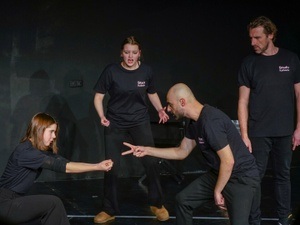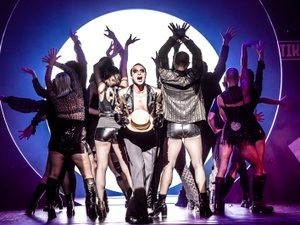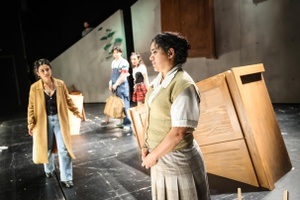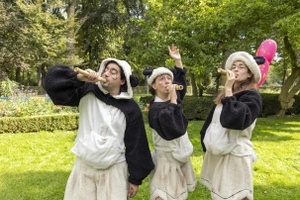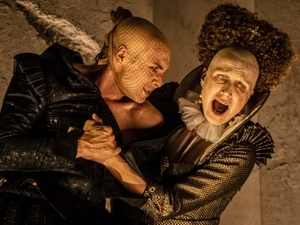Tianzhuo Chen & Siko Setyanto: Ocean Cage
In the organizer's words:
The call "Baleo! Baleo!" can be heard on the coast of the Indonesian village of Lamalera as soon as the fishermen have spotted a whale. For the villagers, the centuries-old cry means that the ancestors will show themselves with the appearance of the whale and bestow their blessing on the village. The ocean has opened up and offers its gifts. It is a call that challenges fate and has existed for centuries.
The solo performance Ocean Cage is anchored in the complex and emotive narrative of the Indonesian village of Lamalera and embraces the entanglement between the whale, the fishermen and the ancestors. In the encounter with the sperm whale, the interrelationships of a complex ecosystem and the basis of solidarity with one another are manifested. The meeting is both a spiritual source and a connection to the ancestors, interwoven like the links of a chain whose beginning and end can no longer be determined. Visitors are invited to immerse themselves in the delicate, silent, troubled ideological trench, to breathe and dissolve into the porous and leaky bodies of water, mammals, fishermen, ballads, breezes and spirits to reflect on the interrelationships between species and how we can (re)understand more-than-human justice. In the immersive environment created by Tianzhuo Chen, Ocean Cage combines elements of installation, film and dance to create the space for the performance, in which Siko Setyanto becomes the central protagonist in changing characters. Together with the Indonesian musicians Kadapat and Nova Ruth, a visual, dance and musical maelstrom is created in which tradition and ecology, spirituality and technology, belief in progress and interspecies symbiosis are whirled together.
In his works, Tianzhuo Chen combines tradition and modernity, high culture and subculture, and alternates between different artistic genres - from visual art and theater to live art, music and video art. As an artist, he regularly produces performances, sculptures and video works, organizes concert and club series with his label Asian Dope Boys and designs fashion. He is just as active and productive on the Internet as he is in real life. For his objects, performances and video works, he uses a colorful, grotesque and sometimes almost kitschy visual language that is characterized by direct references to Asian spiritualism, Butoh dance, voguing and LGBTIQ+ iconography. He interweaves precisely written stories, thoughts and political statements with ritualized happenings of self-empowerment that relate to contemporary club and counterculture.
Tianzuho Chen graduated in Fine Arts from Saint Martins and Chelsea College in London. He returned to China in 2012, where he showed his art in a series of exhibitions that established his reputation. With his first overseas exhibition at the Palais de Tokyo in Paris in 2015, Tianzuho Chen became known in Europe. In the following years, he produced performances and exhibitions around the world and showed several of his works in Germany, including in Berlin, Hamburg and Munich. Tianzhuo Chen was born in Beijing, China, and currently lives in Berlin.
Siko Setyanto is a dancer and choreographer from Jakarta, Indonesia. His artistic practice consists mainly of dance, but he also works multidisciplinary. Siko Setyanto began his training at the age of nine with Wied Sendjayani at the Sanggar Maniratari in Solo, Indonesia. The diversity of Indonesian culture in which Siko Setyanto grew up and the opportunity to participate in jazz and ballet training as a child formed the basis for his dance and choreographic vocabulary. Siko Setyanto founded the DRKR Kolektif as a medium for the exchange of contemporary dance, as a network of dancers from Aceh to Papua. He is a co-founder of Dansity Dance Company, which is dedicated to building a professional contemporary dance company in Jakarta. He currently works as a dancer and choreographer with the Eun Me Ahn Company in South Korea and regularly collaborates with Gabber Modus Operandi. He worked with Tianzhuo Chen on the productions TRANCE and PHYSIS and can now be seen here in Ocean Cage.
Duration: 100 min.
| Fri 22.11. | followed by a talk |
The performance uses strobe lighting and fog. There are passages with loud music, hearing protection is offered free of charge by the evening service. Fish will be fried during the performance. There is a strong smell of fish. There is no traditional seating in the hall. The audience can move freely around the room. The play is performed in Indonesian with English surtitles. The play is also accessible without language.
This content has been machine translated.







